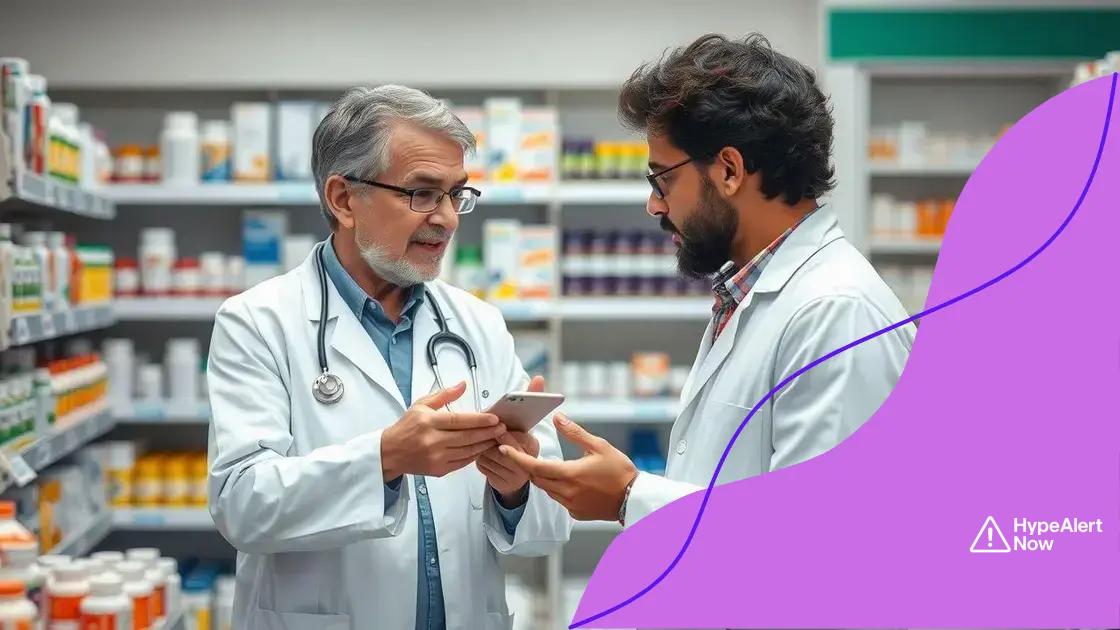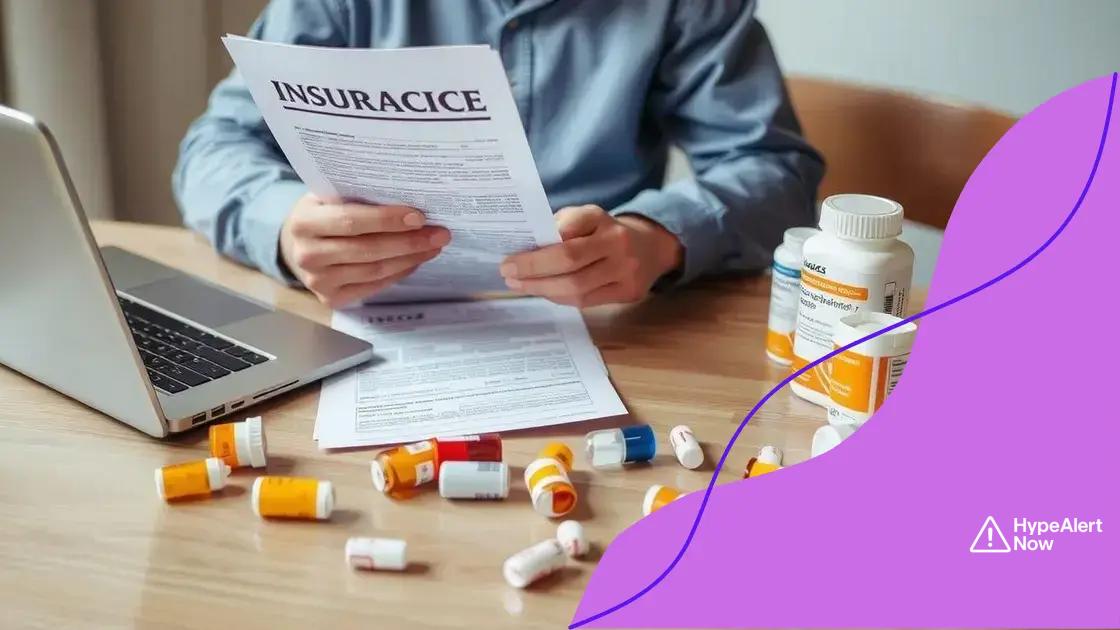Prescription drug cost reduction efforts that can save you money

Prescription drug cost reduction efforts include utilizing pharmacy discount programs, choosing generics, and navigating insurance plans to significantly lower medication expenses.
Prescription drug cost reduction efforts are essential for many families struggling with rising healthcare expenses. Have you ever felt overwhelmed by the cost of medications? Let’s explore some practical steps to bring those expenses down.
Understanding the rising costs of prescription drugs
Understanding the rising costs of prescription drugs is vital for anyone managing healthcare expenses. Over the past few years, many individuals have noticed their medication prices increasing, leading to financial strain. The reasons for these rising costs are complex and multi-faceted.
One major factor contributing to this trend is the research and development expenses incurred by pharmaceutical companies. It can take years and billions of dollars to bring a new medication to market. These expenses are often passed on to consumers, making medications more expensive.
Key Drivers of Rising Costs
Several factors drive the growing prices of prescription drugs. It’s essential to understand these to navigate potential savings effectively.
- Increased demand for specialty medications
- Limited competition in the market
- High advertising costs
- Stringent regulations and approvals
Additionally, the lack of transparency in drug pricing can leave consumers confused. This often results in a situation where individuals pay higher prices without understanding why. Many people are unaware that they may have alternatives available that could significantly lower their costs.
Strategies to Handle Rising Costs
To combat the effects of rising prescription drug costs, consider exploring generic alternatives when available. Generics can provide the same therapeutic benefits at a fraction of the price.
Another helpful strategy is to discuss prices with your healthcare provider. They may have insights on cost-saving medications or can prescribe alternatives that are equally effective but more affordable. Awareness and advocacy can lead to better outcomes.
Top strategies for reducing prescription drug costs
Top strategies for reducing prescription drug costs can help you save money while maintaining your health. Many people are unaware of their options when it comes to lowering medication expenses. Knowing where to look can make a significant difference.
One effective method is to use generic medications. Generics provide the same active ingredients as brand-name drugs but at a lower cost. They are equally effective and often recommended by healthcare providers.
Utilizing Discount Programs
Many pharmacies offer discount programs that can help reduce your out-of-pocket expenses. These programs may include:
- Membership discounts
- Health savings accounts (HSAs)
- Pharmacy coupons and cards
- Manufacturer discounts
An additional tactic is to compare prices between different pharmacies. Prices can vary significantly, so shopping around can lead to substantial savings. Online tools are available that allow you to easily compare prices on your medications across various locations.
Consultation and Alternatives
It’s also helpful to discuss costs with your doctor or pharmacist. They may know of lower-cost options that are just as effective. For example, there might be alternative medications, over-the-counter versions, or therapeutic substitutes available.
Furthermore, checking if your medications are covered under your insurance plan is crucial. Some insurance plans have preferred pharmacies that offer lower costs for certain prescriptions. Understanding your plan can help you make the most of your benefits.
How to navigate insurance plans for savings

Navigating insurance plans for savings can feel challenging, but it’s essential for managing your prescription drug costs effectively. Understanding your insurance can lead to significant savings in medication expenses.
First, identify your plan’s formulary. This is a list of covered medications and often categorizes drugs by their cost. Medications on a lower tier typically have lower co-pays. Knowing what is included can guide you in choosing the right prescriptions.
Understanding Co-Pays and Deductibles
Another vital part of navigating insurance is understanding your co-pays and deductibles. Your co-pay is the amount you pay for a medication, while the deductible is the amount you pay before your insurance kicks in.
- Check how much your deductible is and how much you’ve already paid.
- Know your co-pay for each medication; this can help you budget.
- Some plans may offer lower co-pays for specific pharmacies or during certain times.
- Monitor your spending on prescriptions throughout the year.
Additionally, consider reaching out to your insurance provider for clarification. They can provide specific details on your coverage and help you understand any loopholes. Many companies offer customer support teams specifically to assist with medication inquiries.
Using Health Savings Accounts
A Health Savings Account (HSA) can also help save money on prescription drugs. HSAs allow you to save pre-tax dollars to cover eligible medical expenses, including medications. This can lower your overall costs significantly.
Lastly, stay informed about your plan’s annual changes. Insurance providers can alter co-pays and coverage yearly, so it’s good practice to review your plan each year. Making informed choices regarding your medications and how they fit into your insurance can make navigating the complex world of healthcare feel more manageable.
Resources for finding affordable medications
Finding affordable medications is possible with the right resources. There are several tools and programs designed to help you save money on your prescriptions. By leveraging these resources, you can reduce your costs and access the necessary medications without financial strain.
One effective option is to use online prescription discount services. These platforms allow you to search for lower prices on your medications at local pharmacies. By simply entering the name of your drug, you can find the best deals available. Many of these services are free and can be used easily.
Pharmaceutical Assistance Programs
Many pharmaceutical companies operate patient assistance programs (PAPs). These programs can provide free or discounted medications to eligible individuals. They often have specific income requirements, so it’s important to check if you qualify.
- Check each company’s website for their assistance options.
- Gather necessary documents to ensure a smooth application process.
- Contact your healthcare provider for additional help with the application.
- Keep a list of your medications to simplify the process.
Local health clinics and community organizations can also be excellent resources for affordable medications. Many clinics offer sliding scale fees based on income, making healthcare access easier for those who need it most. These clinics often have connections to discounted medications and can help you find affordable options.
Utilizing Discount Cards and Apps
Additionally, discount cards and mobile apps can help cut costs. Many pharmacies accept discount cards which provide immediate savings on prescriptions. Some of these cards are free and can result in substantial savings.
By staying informed and proactive, you can effectively find affordable medications that meet your healthcare needs without breaking the bank. It’s essential to explore all options available to ensure you receive the necessary treatment while managing your costs wisely.
Impact of pharmacy discount programs
The impact of pharmacy discount programs is significant in helping individuals manage their medication costs. These programs provide substantial savings on both brand-name and generic drugs, making prescriptions more accessible to those with financial constraints.
Many pharmacies offer discount programs to attract customers and provide better prices. These programs often require no membership fees, allowing anyone to take advantage of lower prices. When using these programs, it’s important to check if the specific medication you need is part of the discount plan.
How These Programs Work
Pharmacy discount programs typically work by negotiating lower prices with manufacturers and pharmacies. This can lead to dramatic reductions in the prices of medications. When a consumer presents a discount card or coupon, it can reduce the cost significantly:
- Discounts can range from 10% to 80% on various medications.
- Some programs offer fixed pricing for commonly used medications.
- Many programs allow usage without insurance, offering savings even if you are uninsured.
- Discounts can help individuals who are underinsured or facing high deductibles.
These programs can improve medication adherence, as lower costs may encourage individuals to fill their prescriptions. When medications are more affordable, patients can avoid skipping doses or not filling prescriptions due to cost concerns.
Finding the Right Program
To maximize savings, research which programs are available in your area. Tools such as online price comparison websites can help you identify which pharmacies offer the best discounts. Many discount programs can be accessed through mobile apps, making it easier to track and find savings while managing your medications.
In conclusion, pharmacy discount programs can meaningfully impact reducing the financial burden of medications, allowing more individuals to access necessary treatments without worrying about costs.
FAQ – Frequently Asked Questions about Prescription Drug Cost Reduction
What are pharmacy discount programs?
Pharmacy discount programs are services that offer lower prices on medications, allowing consumers to save significantly on their prescriptions.
How can I find affordable medications?
You can find affordable medications by using online comparison tools, checking local pharmacies, and utilizing discount cards.
What is a Health Savings Account (HSA)?
A Health Savings Account (HSA) allows you to save pre-tax money to cover eligible medical expenses, which can include prescription medications.
How do generic medications save money?
Generic medications contain the same active ingredients as brand-name drugs but are usually sold at a lower price, leading to significant savings.
